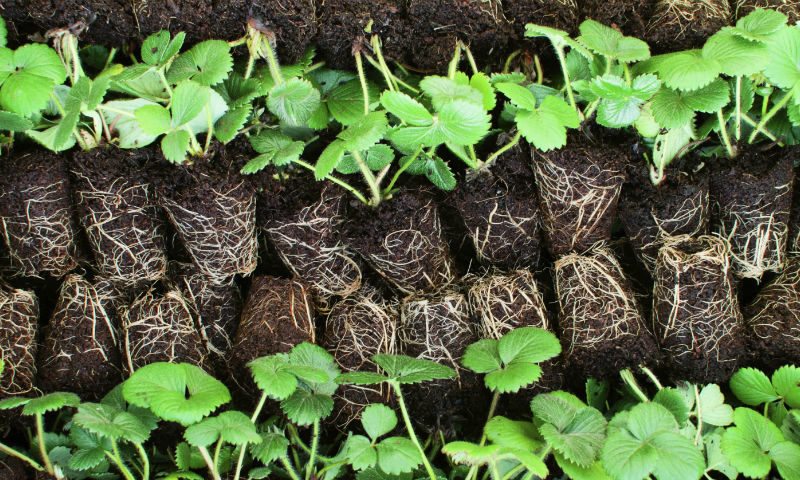
Exploring New Media Options
Creating, as well as maintaining, optimal physical and chemical properties of media is extremely important for successful young plant production. Loose-filled plug trays are the most widely used media for young plant production globally. It is the most inexpensive way to start young plant production. As a matter of fact, there is no better plug media than loose-filled trays if the media is structurally stable during propagation. However, since the plugs are loosely filled, the media settles during the course of propagation, especially in the case of larger plugs. This will result in compromised air to water ratio and can affect the rooting response. Also, in the case of loose filled trays, if the transplant occurs before the formation of complete a root ball, the root system is disturbed and consequently could delay the transplant performance.
There are a few stabilized propagation media available in the market addressing these issues. However, with the introduction of new plant types, change in propagation procedures and the evolution of new transplant equipment, the industry needs new and improved propagation media technologies.
Terra Plug is one of the new propagation media technologies that is developed for a wide variety of applications. This includes propagation of cuttings from herbaceous plants, hardwood trees and tissue culture propagules, seeds and grafted vegetables. The plugs are made by loose filling the propagation trays with peat and coco blend and stabilizing the media with a unique plant friendly technology.
The media particles are physically bonded and structurally stabilized. Therefore, peat and coco maintain their natural structure during the entire propagation process and provide optimal aeration for uniform, fast and superior rooting. The patented plug release technology allows for easy extraction of the young plants at transplant. These plugs are ready to use when they arrive at the grower locations.
Following are some case studies using Terra Plug.
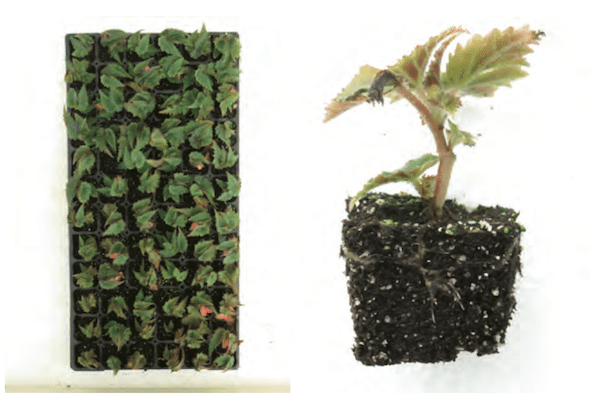
Vegetative Propagation of Herbaceous Shootip Cuttings
Begonia ‘California Sunlight’ has bright orange flowers and dark foliage and is excellent for mixed containers or baskets. These cuttings require well-drained and aerated media for good rooting. If the media stays saturated, the rooting will be delayed and rooting performance will be poor.
In this study, cuttings were propagated in peat, perlite and vermiculite based loose-filled plug trays and Terra Plugs. The cuttings were propagated under intermittent mist with bottom heating and no rooting hormones were applied. Rooting evaluation was conducted 20 days after insertion. The rooting response was extremely uniform and significantly better with strong fibrous root system in Terra Plug compared to loose fill.
Regarding extraction, 100 percent of the cuttings rooted in Terra Plugs were extractable with no damage to the root system, compared to only 10 percent of the cuttings rooted in loose-filled media (Figure 1). In general, Terra Plug rooted cuttings were four to six days ahead compared to loose-fill rooted cuttings with regard to root growth and extractability. Also, the shoot growth was superior in the cuttings rooted in Terra Plug.
Vegetative Propagation of Hardwood Cuttings
Propagating semi-hardwood and hardwood cuttings can be challenging and the success rate can be very low. The rooting usually takes several months, and these cuttings do not like the media to stay saturated during propagation. Typically, most of the semi-hardwood and hardwood cuttings are propagated in 50 percent perlite + 50 perlite sand, 100 percent sand, or peat with high amounts of perlite.
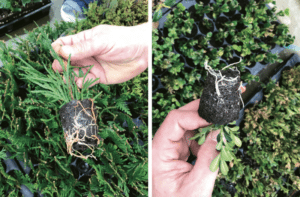
In this study, cuttings from Emerald Arborvitae and Green Gem Boxwood were propagated in sand and perlite based loose-filled plug trays and Terra Plugs. All the cuttings were dipped in Hormodin 0.3 percent before sticking and rooted under boom irrigation with bottom floor heating. The majority of the cuttings from Emerald Arborvitae rooted in eight weeks and Green Gem Boxwood rooted in 12 weeks after sticking in Terra Plugs (Figure 2). On the other hand, very limited to no rooting was observed in perlite and sand based blends (data not shown).
Grafted Vegetable Seedling Production
Grafted vegetable seedling production for field transplant is extremely popular and quite common in several Asian and European countries. Although the numbers are very low in the North American market currently, this might change in the near future as further improvements become available with grafting automation technologies.
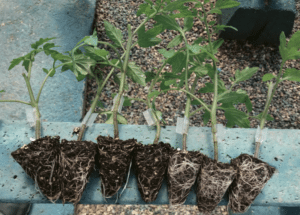
Grafting is generally performed in Cucurbitaceae (watermelons, cucumbers and other melons) and Solanaceae (tomatoes, peppers and eggplants) to 1) achieve resistance to soil borne plant pathogens; 2) increase flavor, vigor and yields; and 3) acquire tolerance to abiotic stresses such as chilling injury.
In the case of solanaceous crops, the scion or variety is grafted onto the rootstock that still has its root system and cotyledon devoid grafting method is used. Whereas, in the case of cucurbits, cotyledon devoid or single cotyledon grafting method is used depending on the type of rootstock. In addition, re-rooting of grafts is preferred in cucurbits rather than grafting onto the rootstock that still has its root system because the success rate of grafting is higher when the rootstocks are re-rooted. For grafted plant production, faster seedling production along with a strong root system allows for early and successful grafting as well as improved transplant performance.

In the studies described, tomato rootstock was propagated and grafted in peat and perlite based loose-filled plug trays and Terra Plugs in the Almeria region in Spain (Figure 3). Also watermelon seedlings were grafted and re-rooted in peat and perlite based loose-filled plug trays and Terra Plugs in Korea (Figure 4).
Personal communication with customers at the trials sites indicated that rootstock production in Terra Plug allowed earlier grafting by four to five days. In addition, grafts raised in Terra Plugs were ready for field transplant one week faster compared to their counter parts in loose fill.

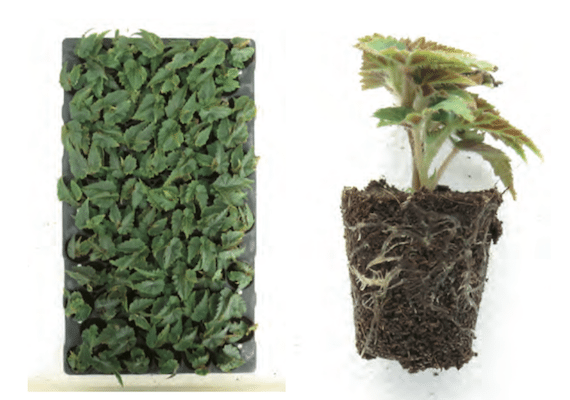

 Video Library
Video Library 




















